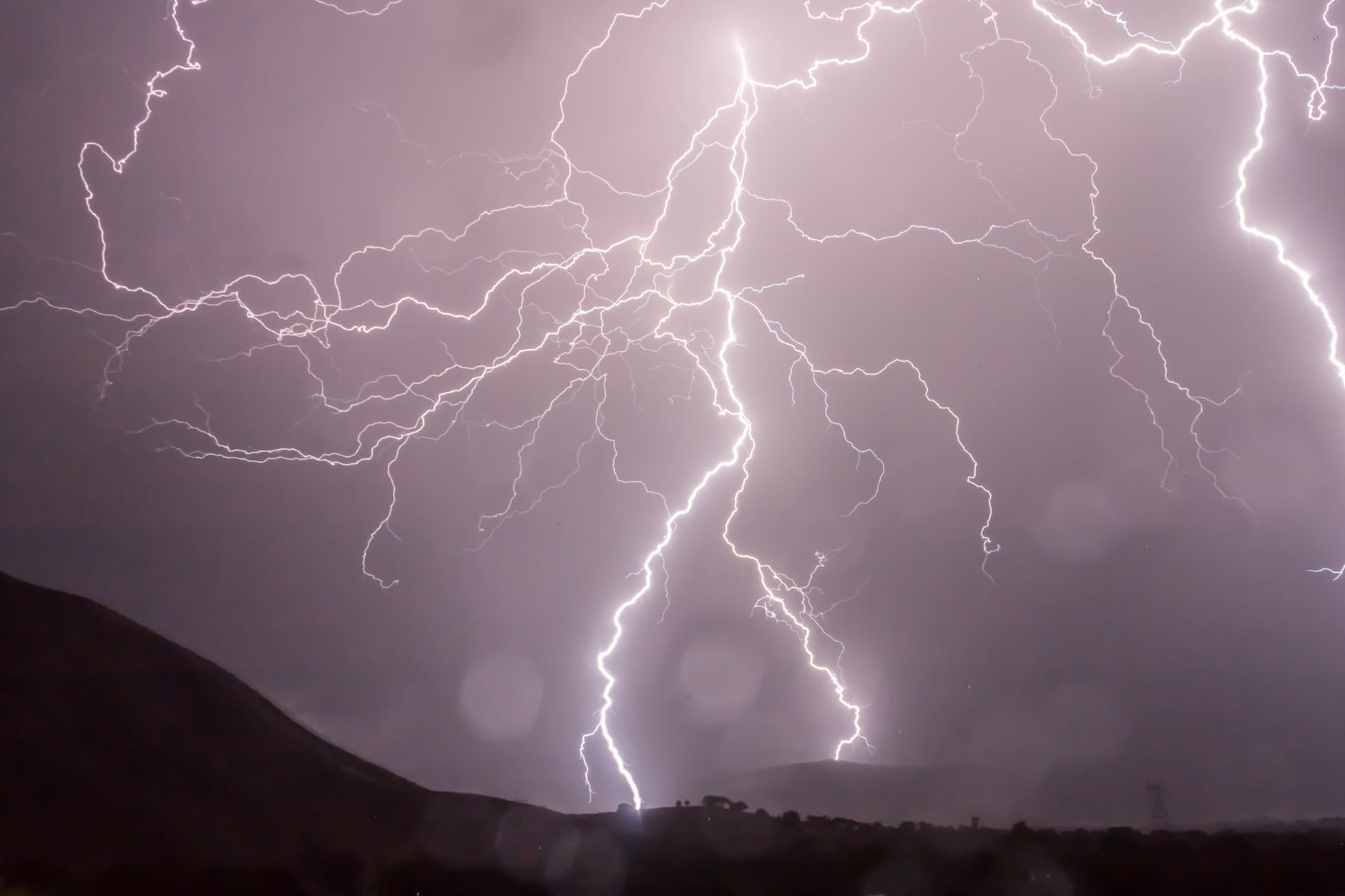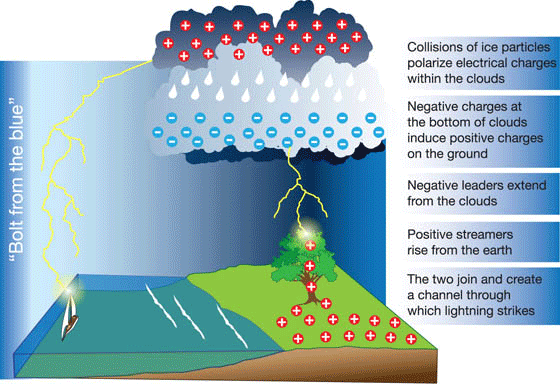WHAT IS LIGHTING, AND WHAT CAUSES IT??
Hello guys, @pasaift here.
After experiencing a lightning storm and heavy downpour last night, I decided to make this post which potrays what lightning is and what causes it's occurrence.
Many individuals have their own definition of lightning and thunder. Lightning is one of the forces of nature and as such has been analysed in different forms based on legends, religion and myths. Sorry to burst your bubble believers of different ideology, the occurrence of lightning is just a natural phenomena.
Lightning is a sudden electrostatic discharge which is usually seen as flashes of light during an electrical/thunderstorm.
CAUSE OF LIGHTNING
As stated Earlier that lightning is electrostatic discharge, for this discharge to occur there must first be the presence of clouds. It is practically impossible for lightning to occur without clouds being present. Lightning occurs as a result of wind updrafts and downdraftsee that happens in the atmosphere. These drafts creates a kind of charging mechanism that separates the positive and negative charges in the cloud. The constituents of the clouds ( ice particles and water) enhances the charge separation. Positive charges becomes concentrated near surface of the Earth, and the Negative charges concentrate near the bottom of the clouds.
While this is occurring, a positive net charge is formed on the surface. Physics tells us that ‘like’ charges repel each other and opposite charges will attract. The separation between the surface and the clouds sets the stage for an electrical charge to occur between the two. The air starts to break into a pathway that the electrical charges can travel through. This pathway is formed when the air becomes ionized between the cloud and Earth (positive ions will want to travel up to towards the cloud to become neutralized). This pathway is lightning! You would think that this ‘pathway’ would be a straight line in nature, fact is that ‘air’ is made up of other particles, dust, and such that will interfere and will break down quickly creating the usual jagged lines of the lightning.
TYPES OF LIGHTNING
Lightning can take one of three forms, which are defined by what is at the "end" of the branch channel (i.e. lightning bolt). For example, there is intra-cloud lighting (IC), which takes place between electrically charged regions of a cloud; cloud-to-cloud (CC) lighting, where it occurs between one functional thundercloud and another; and cloud-to-ground (CG) lightning, which primarily originates in the thundercloud and terminates on an Earth surface (but may also occur in the reverse direction).
Intra-cloud lightning most commonly occurs between the upper (or "anvil") portion and lower reaches of a given thunderstorm . In such instances, the observer may see only a flash of light without hearing any thunder. The term "heat-lightning" is often applied here, due to the association between locally experienced warmth and the distant lightning flashes.
In the case of cloud-to-cloud lightning, the charge typically originates from beneath or within the anvil and scrambles through the upper cloud layers of a thunderstorm, normally generating a lightning bolt with multiple branches.
Cloud-to-ground (CG) is the best known type of lightning, though it is the third-most common – accounting for approximately 25% cases worldwide. In this case, the lightning takes the form of a discharge between a thundercloud and the ground, and is usually negative in polarity and initiated by a stepped branch moving down from the cloud.
CG lightning is the best known because, unlike other forms oflightning, it terminates on a physical object (most often the Earth), and therefore lends itself to being measured by instruments. In addition, it poses the greatest threat to life and property, so understanding its behavior is seen as a necessity.
PROPERTIES OF LIGHTNING
As stated Earlier, Ligthning originates when wind updrafts and downdrafts take place In the atmosphere, creating a charging mechanism that separates electric charges in clouds – leaving negative charges at the bottom and positive charges at the top. As the charge at the bottom of the cloud keeps growing, the potential difference between cloud and ground, which is positively charged, grows as well.
When a breakdown at the bottom of the cloud creates a pocket of positive charge, an electrostatic discharge channel forms and begins traveling downwards in steps tens of meters in length. In the case of IC or CC lightning, this channel is then drawn to other pockets of positive charges regions. In the case of CG strikes, the stepped leader is attracted to the positively charged ground.
Many factors affect the frequency, distribution, strength and physical properties of a "typical" lightning flash in a particular region of the world. These include ground elevation, latitude, prevailing wind currents, relative humidity, proximity to warm and cold bodies of water, etc. To a certain degree, the ratio between IC, CC and CG lightning may also vary by season in middle latitudes. About 70% of lightning occurs over land in the tropics where atmospheric convection is the greatest. This occurs from both the mixture of warmer and colder air masses, as well as differences in moisture concentrations, and it generally happens at the boundaries between them. In the tropics, where the freezing level is generally higher in the atmosphere, only 10% of lightning flashes are CG. At the latitude of Norway (around 60° North latitude), where the freezing elevation is lower, 50% of lightning is CG.
EFFECTS OF LIGHTNING
In general, lightning has three measurable effects on the surrounding environment.
First, there is the direct effect of a Lightning strike itself, in which structural damage or even physical harm can result. When lighting strikes a tree, it vaporizes sap, which can result in the trunk exploding or a large branches snapping off and falling to the ground.
When lightning strikes sand, soil surrounding the plasma channel may melt, forming tubular structures called fulgurites. Buildings or Tall structures hit by lightning may be damaged as the lightning Seeks unintended paths to ground. roughly 9% of people struck by lightning survive,as humans or animals struck by lightning suffer severe injury due to internal organ and nervous system damage.
Thunder is also a direct result of electrostatic discharge. Because the plasma channel superheats the air in its immediate vicinity, the gaseous molecules undergo a rapid increase in pressure and thus expand outward from the lightning creating an audible shock wave (aka. thunder). Since the sound waves propagate not from a single source, but along the length of the lightning's path, the origin's varying distances can generate a rolling or rumbling effect.
High-energy radiation also results from a lightning strike. These include x-rays and gamma rays, which have been confirmed through observations using electric field and X-ray detectors, and space-based telescopes.
Take home fact: The heat from lightning is actually greater than that of the sun. Approximately six(6) times hotter. It's temperature is speculated to be around 27000°C.
@pasaift


Was hoping to see the part where I learn how to become a real-life Flash, But all I saw was pain.... :(
This was well researched and written, well done. While reading a part caught my attention.
My interpretation of this statement sounded quite strange to me. Does this mean lightening can sometimes originate from the ground?
Lolz, the flash. thank you for reading. Now about happening in reverse Is a theoretical possibility based on law of physics though I've not seen this is real life
Oh, hmm interesting. never knew that. We learn everyday.
Great..
Thank you.
Urwell guys
Great work man!
Thanks for stopping by
This is educative
Thanks man
That's a surprising number, I thought the % of people surviving would be lower.
Lighting will always be something a little bit intimidating, so I cannot imagine the shock one person must feel when being touched by one.
Oops!! Sorry that was a typographical error. Thanks for spotting it out. I've made necessary correction.
I think the 90% number was right mate, but it is surprising because lighting seems much more dangerous.
The lightning was scary wee too fam.
Great piece!
Thanks man
Hello, another important aspect is that it SCARES... Hehe!
Lolz yeah I forgot to mention that
Congratulations @pasaift! You have completed some achievement on Steemit and have been rewarded with new badge(s) :
Click on any badge to view your own Board of Honor on SteemitBoard.
To support your work, I also upvoted your post!
For more information about SteemitBoard, click here
If you no longer want to receive notifications, reply to this comment with the word
STOP